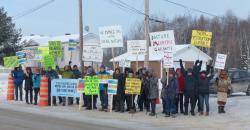(Montreal/Saint-Michel-des-Saints) A coalition of elected officials, citizens and organizations united under the banner of the Better Mining coalition ("Pour que le Québec ait meilleure mine!") denounces Quebec’s decision to authorize a mega open-pit mine in a tourist area, adjoining Mont-Tremblant National Park and Lac Taureau Regional Park. They are reacting to the authorization decree for the Nouveau Monde Graphite mine published this morning by Quebec.
“After analysing the decree, we note that Quebec has decided to close its eyes to several missing studies, concerning the risks of water pollution, the management of acid waste, and the impact of this mine in this environment, highly valued for tourism,” said Ugo Lapointe, spokesperson for the coalition and Canada Program Coordinator for MiningWatch Canada.
The project aims to excavate an open pit nearly 2.7 km in length and will generate more than 107 million tonnes of mining waste, including millions of tonnes of acid waste that will have to be stored in perpetuity in the watershed of the Lac Taureau Regional Park. Nouveau Monde Graphite is specifically aiming to supply the electric car market.
Warnings ignored, ministerial promises broken
Daniel Tokatélof of the Association de protection du Lac Taureau said, “Quebec ignored the advice of the Office of Public Hearings on the Environment (BAPE) to require all the missing studies be submitted before authorizing the project. It’s extremely disappointing and we are very worried about what will happen now.”
The coalition notes in particular that the decree makes no mention of the lack of social acceptance of the project and of social division locally, nor of the opposition of the Atikamekw Nation of Manawan, which claims ancestral rights in this territory. The BAPE had also recommended that Quebec act on this front.
The decree asks the mining company to submit the missing studies at a later date. May Dagher, of the Coalition Against a Mining Project in Haute Matawinie, commented, “This decision is all the more appalling because the Minister of the Economy, Mr. Fitzigibbon, had promised us to our faces that Quebec would follow all the recommendations of the BAPE before authorizing such a project.”
Mega pit, blasting, acid drainage: a new challenge for tourist areas
“Quebec's decision to authorize a mine of such a scale in a tourist area is a surprise for the dozens of lake associations, municipalities, and citizens who are currently mobilizing in the Laurentides, Lanaudière, and Outaouais regions against a boom in graphite mining projects,” said Louis St-Hilaire of the Regroupement pour la protection des lacs de la Petite Nation.
Denis Fillion, deputy mayor of the small municipality of Grenville-sur-la-Rouge, which faced a $96 million lawsuit from the Canada Carbon mining company in 2018, agreed, saying, “Quebec must review the Mining Act and the areas that are incompatible with mining activities to better define this industry.”
Last October, many organizations and elected officials co-signed an open letter asking Quebec to implement “Three Principles to Avoid Undermining the Transition.” Ugo Lapointe said, “If Quebec claims to want to responsibly supply the electric vehicle market with its mineral resources, it must urgently review its laws so as not to sacrifice lakes, communities, and territories that are highly valued for tourism and other local economies.”
Contact: Ugo Lapointe (514) 708-0134
The Quebec meilleure mine! coalition is a bona fide organization founded in 2008 and its mission is to promote best mining practices and policies on the social, environmental and economic levels in Quebec. Today, it brings together some thirty organizations that collectively represent more than 300,000 individuals from across Quebec. The current members of the coalition are:
- Action boréale Abitibi-Témiscamingue (ABAT)
- Alternatives
- Artistes pour la Paix
- Association canadienne des médecins pour l’environnement (ACME)
- Association de protection de l’environnement des Hautes-Laurentides (APEHL)
- Association québécoise de lutte contre la pollution atmosphérique (AQLPA)
- Centrale des syndicats du Québec (CSQ)
- Centre de recherche en éducation et formation relatives à l’environnement et à l’écocitoyenneté
- Coalition de l’ouest du Québec contre l’exploitation de l’uranium (COQEU)
- Coalition Stop Uranium de Baie-des-Chaleurs
- Comité de vigilance de Malartic
- Conseil centrale CSN de l’Abitibi-Témiscamingue et du Nord-du-Québec
- Écojustice
- Eco-vigilance Baie-des-Chaleurs
- Environnement Vert Plus Baie-des-Chaleurs
- Fondation Rivières
- Forum de l’Institut des sciences de l’environnement de l’UQAM
- Groupe solidarité justice
- Les AmiEs de la Terre du Québec
- Justice transnationale extractive (JUSTE)
- MiningWatch Canada
- Minganie sans uranium
- Mouvement Vert Mauricie
- Nature Québec
- Professionnels de la santé pour la survie mondiale
- Regroupement citoyen pour la sauvegarde de la grande baie de Sept-Îles
- Regroupement pour la surveillance du nucléaire
- Regroupement vigilance sur les mines en Abitibi-Témiscamingue
- Réseau œcuménique justice et paix (ROJeP)
- Réseau québécois des groupes écologistes (RQGE)
- Sept-Îles sans uranium
- Société pour la nature et les parcs (SNAP-Québec)
- Société pour vaincre la pollution (SVP)
- Syndicat de la fonction publique et parapublique du Québec (SFPQ)
